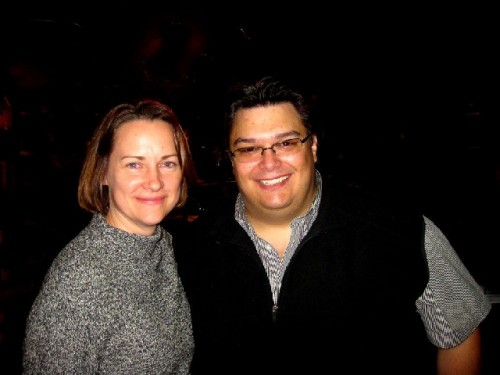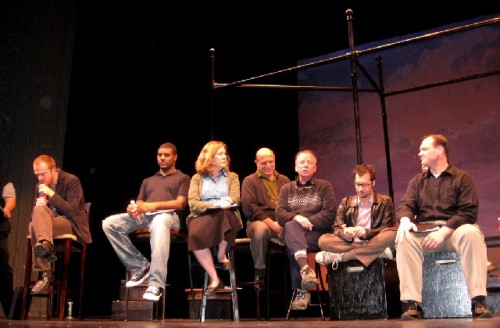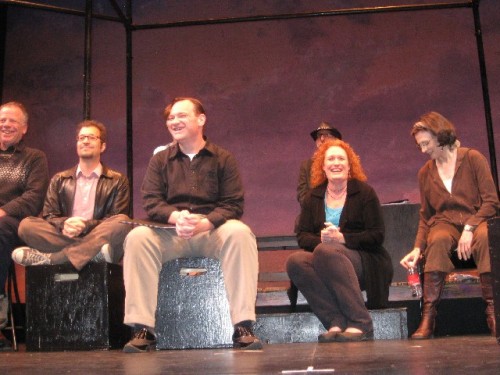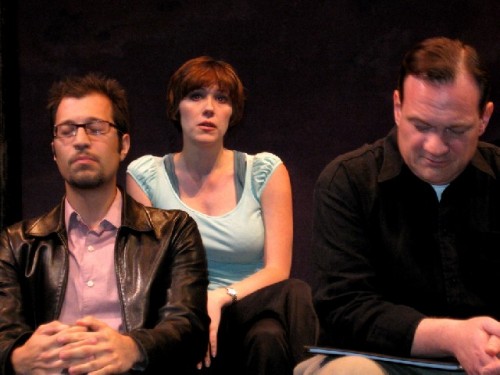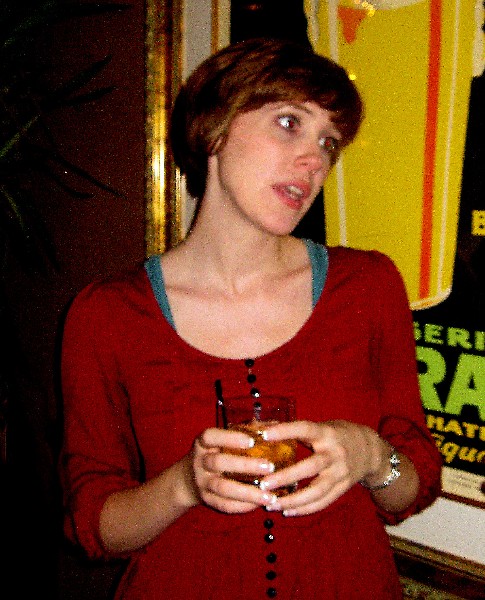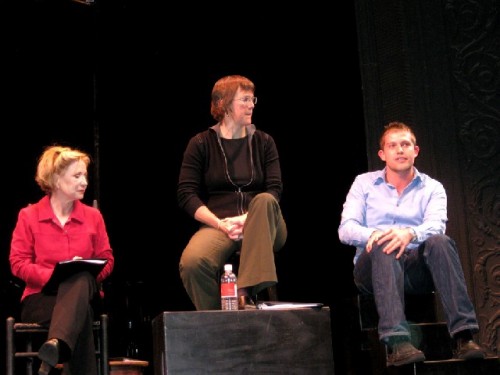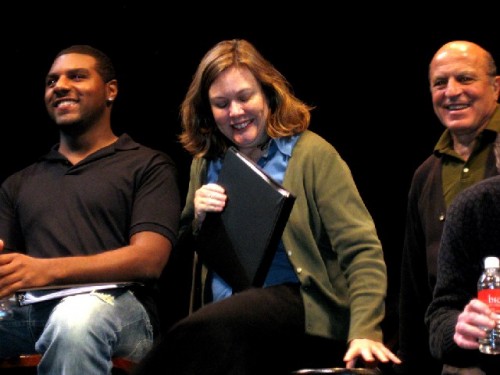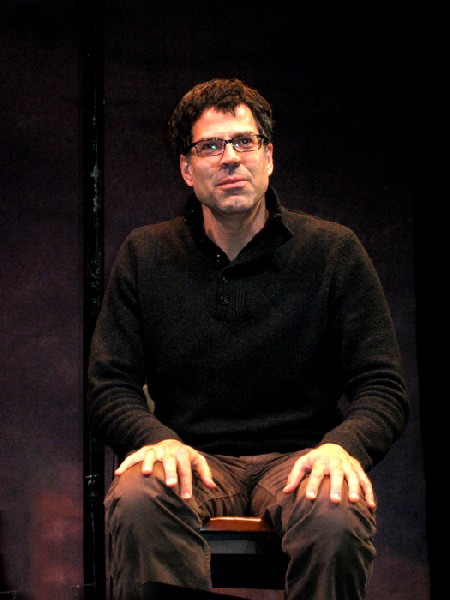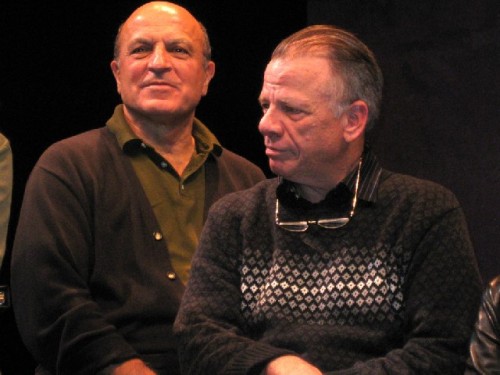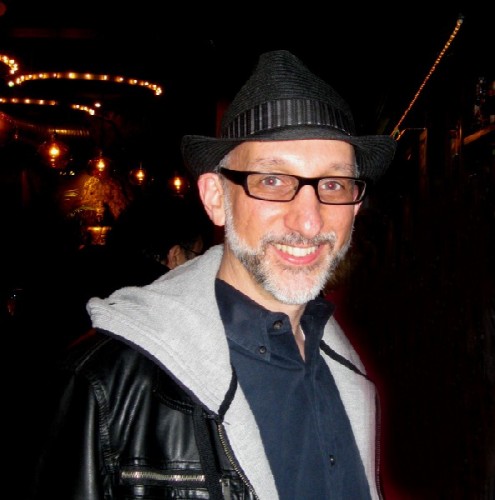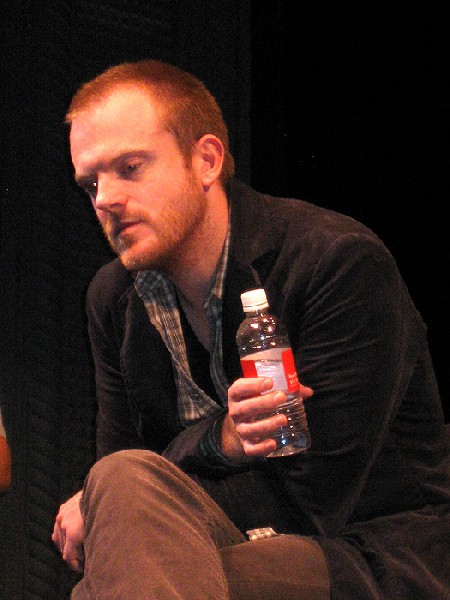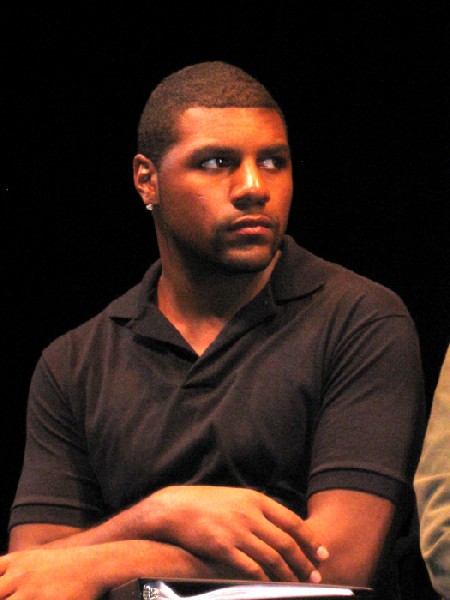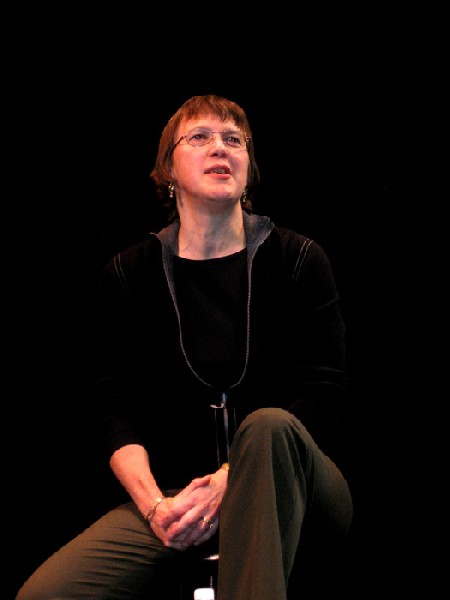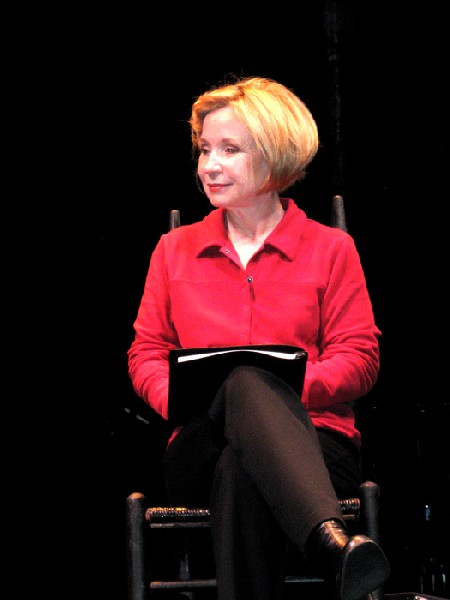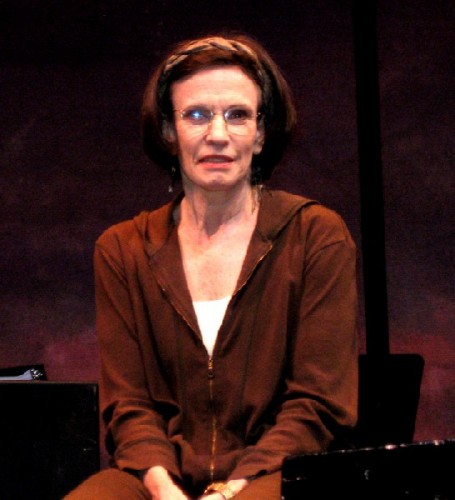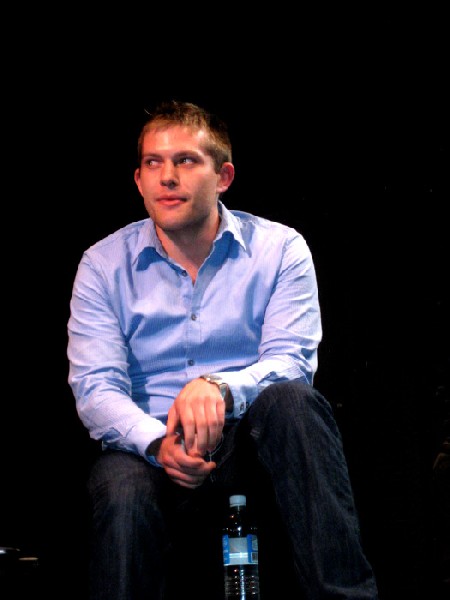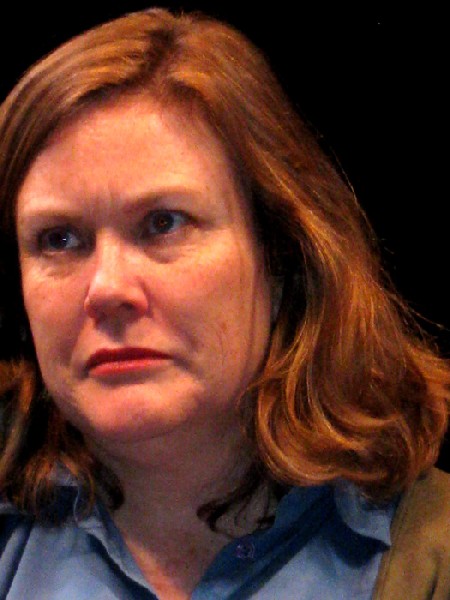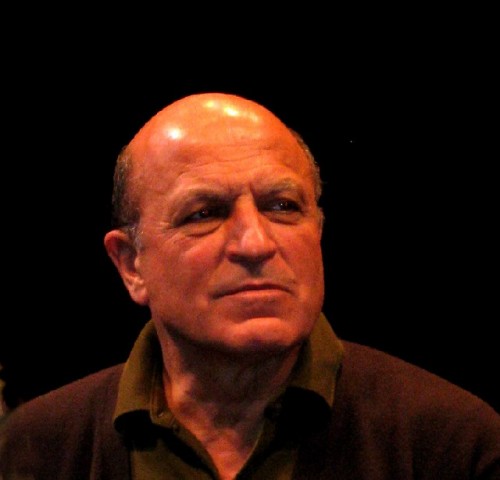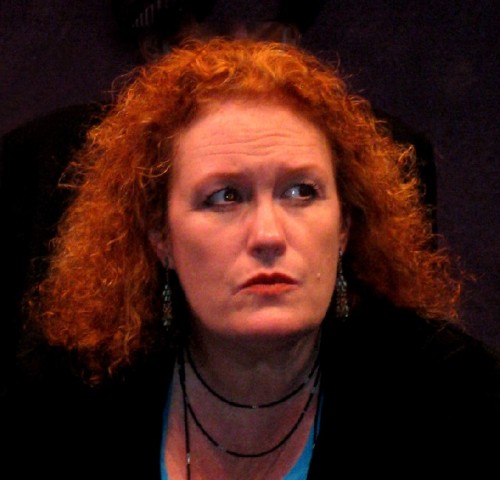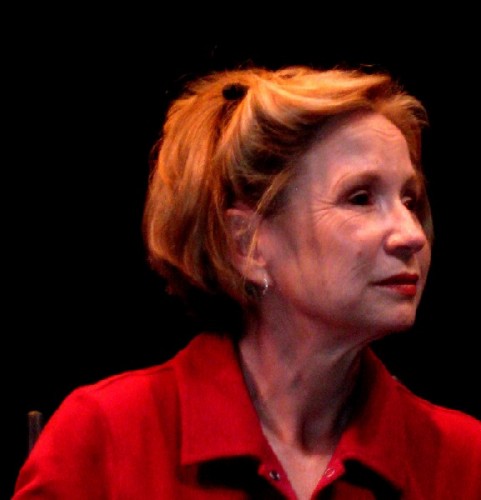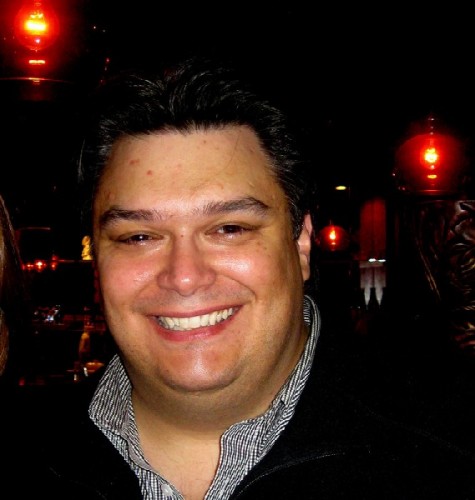Barrington Stage Company Presents Laramie Project: An Epilogue
All Star Cast of Actors and Community Leaders
By: Charles Giuliano - Oct 14, 2009
The Laramie Project Ten Years Later: An Epilogue
By Moises Kaufman, Leigh Fondakowski, Greg Pierotti, Andy Paris and Stephen Belber of the Tectonic Theater Project
Directed by Richard M. Pairson, Jr.
Lights, Jeff Davis; Original music, Brad Berridge; Press, Charlie Sidenburg; Stage Manager, Thomas J. Coppola
Cast: Jeremy Bobb, Emily Taplin Boyd, Kevin Carolan, Thom Christopher, Tandy Cronyn, Mark H. Dold, Christopher Innvar, Jeff Kent, Seth Rogovoy, Debra Jo Rupp, Enrico Spada, Jerome Spratling, Lisken van Pelt Dus, Ryan Wightman, Megan Wilden, Peggy Pharr Wilson
Barrington Stage Company
Pittsfield, Mass.
October 12, 2009
After six days in a coma, on October 12, 1999, Matthew Shepard died from injuries inflicted in a brutal beating by Russell Arthur Henderson and Aaron James McKinney. It was considered a hate crime and a paradigm of violence to gays. The crime inspired The Laramie Project created by the Tectonic Theatre Project.
A decade later Moises Kaufman, Leigh Fondakowski, Greg Pierotti, Andy Paris and Stephen Belber of Tectonic Theater Project returned to Laramie and conducted a series of interviews with the officers in charge of the investigation, the parents of Matthew Shepard, his friends and neighbors, faculty and students of the University of Wyoming, politicians, and activists.
The team managed to interview both Henderson, who claims that, while an accomplice in the abduction and robbery, he did not participate in beating Shepard, and the unrepentant, neo Nazi, and openly homophobic McKinney. This material was edited into the docudrama The Laramie Project Ten Years Later: An Epilogue.
The Matthew Shepard murder, in which he was robbed, tied to a fence, beaten with a McKinney's then new 352 Magnum pistol, has lent its name to pending Federal legislation regarding hate crimes. But there are those who deny this is the case.
In late 2004, ABC's Elizabeth Vargas, reported on an investigation into the murder for the television program 20/20. Though Vargas primarily relied on personal interviews with people involved with the matter, the report was billed as exploring "New Details Emerging in the Matthew Shepard Murder."
The TV news magazine report alleged that the murder had been motivated by drugs rather than provoked by Shepard's sexual orientation. McKinney, Henderson and Kristen Price (McKinney's girlfriend) alleged that the attack was a result a drug binge and robbery. Yet Price told Vargas "I do not think it was a hate crime at all. I never did." In Price's first interview with 20/20 in 1998 she said that "They just wanted to beat him bad enough to teach him a lesson, not to come on to straight people, and don't be aggressive about it anymore." In the report, Price and McKinney's long-time friend Tom O'Connor, on whose property McKinney and Price once lived, both stated their belief that McKinney was bisexual. O'Connor stated that he and McKinney had sex in the past. McKinney denied that he had experienced sex with a man when questioned about this by Vargas.
Aspects of the devastatingly, sensational and controversial 20/20 broadcast are an essential part of the newly revived Laramie Project. Another key revision focuses on the astonishing jailhouse interviews with the two convicted killers who are serving consecutive life sentences with no possibility of parole.
During a sequence with the mother of Shepard, now an activist for gay rights, she commented how she and her husband had agreed to ask the court to remove the death penalty. The motive would be to avoid the harrowing plea process that would drag on for years and represent sustained emotional stress. Her hope was just to get rid of the convicted killers, to bury them in a deep, dark dungeon, and move on with their lives. Ironically, the interviews conducted by the Tectonic Theater Project evoked the emotional burden she had hoped to avoid.
On October 12, the 10th anniversary of the brutal murder and hate crime for which the very name, Matthew Shepard, has become a signifier, there were some 120 simultaneous productions of the revived play in theaters all over America. It represented a grass roots, community based, coordinated effort.
In Pittsfield a staged reading directed by Richard M. Pairson, Jr. occurred during the first ever Out in the Berkshires, Columbus Day holiday, three day weekend. The reading was staged twice, with a matinee and evening performance. Following the evening performance we attended there was a discussion between the sixteen cast members and the director and those in the audience that remained in the theater. This considerably added to the impact of the production.
The final question of the evening, from an emotionally overwhelmed, openly gay, young man proved to be devastating. In essence he thanked the members of the cast for caring about gay issues. Struggling to hold onto his composure Parison ended the meeting and bolted off stage.
We caught up with Parison during the cast party at Jae's Spice. Recalling the incident and its impact he said "This is precisely why we did this. To reach out to the next generation of activists."
Many who were in the thick of social and political changes of the 1960s have come to regard young people today as apathetic. During my years as a college professor it was often frustrating to lead students in discussions of our horrendous history and sustained need for change.
Arguably, this production preached to the converted as there were relatively few young people in the audience. While absorbing it was more an experience of agit-prop than an evening of theatre. There was so much information conveyed in the many segments, particularly details of failed and stalled attempts to initiate legislation on the state and federal level, that it was difficult to follow and understand all the complex threads.
Significantly, during the discussion someone asked how she might obtain copies of the new script to present it to her students. The earlier version of The Laramie Project has been widely produced in schools and universities. Its primary value is educational rather than theatrical.
The Barrington production did however involve riveting passages. The matrix of the evening occurred during jailhouse interviews with the convicted killers. Jeremy Bobb (Barrington's Sleuth) was outstanding in channeling the hate filled McKinney. At the urging of the prison Chaplin he consented to meeting with the Tectonic team although he stated that "I hate the f----- media."
It was chilling when he snarled that he is better off "in here than outside." He conveyed a sense of honor among thieves and that he is respected by fellow inmates because everyone "knows where I stand." He discussed how in the prison's hierarchy gay inmates stick to themselves and are left alone. "I'm a criminal and I belong living with other criminals." When asked about killing Shepard he chillingly stated that he deserved what he got. Expressing no regret for his crime he revealed that he had some sympathy for the parents and their loss.
The interviewer posed a hypothetical question about where he would go in the unlikely event of his release? "Germany or Italy" was the answer. He elaborated his fascination with Nazi Germany and limited reading of that history. "But they would probably arrest me" he added. "Because of my swastika tattoos which are illegal in Germany." He said that he aspired to have a "shirt" of tattoos and explained how they are done clandestinely in prison.
The audience commented on, and asked questions about, the contrast in the two killers who remain close even in prison. Henderson has constantly changed his story and is clearly the weak follower of McKinney. He claimed to have loosely tied Shepard to the fence post, so he might get away after the beating. And that he ran and hid during the beating which he did not participate in. McKinney backs Henderson's story saying that he had nothing to do with the murder and "doesn't deserve to be in here."
There was a discussion of the leader/ follower pattern of killers. There were comparisons to other partners in crime including Perry Smith and Richard Dick Hickock, as well as Nathan Freudenthal Leopold and Richard Albert Loeb. Compared to these other pairs of killers McKinney and Henderson are numbingly ordinary.
The other pairs of killers inspired remarkable books. Meyer Levin published Compulsion in 1956. This book which conflated fact and fiction inspired the faction of Truman Capote and the New Journalism which resulted in the book In Cold Blood in 1966. Both books were adapted as films.
These landmark books, as well as the two versions of the Laramie Project, raise issues of the boundary between art and real life. The first example of this phenomenon was Dostoyevsky's Crime and Punishment (1866) in which the impoverished student, Rodion Romanovich Raskolnikov, aspired to commit "the perfect crime." As a sociopath Raskolnikov matched wits with the investigator whom he regarded as his intellectual inferior.
This was precisely the behavior of Leopold and Loeb who were prodigies at 19 and 18 when they murdered 14 year old Bobby Frank. Both had already completed their undergraduate education at the University of Chicago and were intending to complete law degrees. In addition to the proto existentialism of Dostoyevsky the killers were inspired by Nietzsche's notion of the Superman.
The wealthy parents of Leopold and Loeb retained the services of Clarence Darrow for the 1924 trial in Chicago. The following year Darrow defended John Scopes in "The Monkey Trial." In his summation Darrow made a compelling argument against capital punishment. Loeb was later murdered in prison. After 33 years Leopold, by then a physician, was released and died at 66 in Puerto Rico. He had been a model prisoner who volunteered for medical research projects and taught other inmates.
While researching In Cold Blood and the murder of four members of the Clutter family Capote seemingly befriended Perry Smith. He used his relationship to trick Perry into revealing details of the crime. The complexity of the relationship ultimately exacted a steep price from the author. While the book is regarded as a masterpiece it destroyed Capote as a human being and artist. He produced little or nothing after that and devolved into alcoholism. In the arts one pays the price for making a pact with the devil to descend into the dark side. That notion dates back to Dante.
The compelling thrust of the first and second versions of the Laramie Project is the manner in which the senseless murder has conflated with legislation, a broader understanding of hate crimes, and the need for activism. The premise of the new version is to revisit Laramie and chronicle how the community has responded and changed. Or not.
With intense but limited rehearsal time the mix of professional actors and community leaders created a remarkable experience for the audience. Unless you knew all of the players it was difficult to define the line between volunteers and seasoned performers.
Seth Rogovoy, the editor of Berkshire Living Magazine, did a terrific job as the narrator introducing the many individual characters and setting up scenes. He wrote a running blog of his experiences during the rehearsals. During the after party we asked if this might represent a new career move. "I hope not" was his frank reply.
We had similar questions for Megan Whilden who is the cultural coordinator for the City of Pittsfield. "I now have a greater understanding of all of the work that goes into a production." Her associate, Ryan Weightman, also participated in the project.
The all star cast included actors who have appeared in previous Barrington productions. It was interesting to see them in this different context. Enrico Spada was "borrowed" from Shakespeare & Company. He was poignant and compelling as Henderson.
Christopher Innvar, who played Stanley Kowolski in Streetcar Named Desire had the important role of Moises Kaufman the leader of the Tectonic team. Emily Taplin Boyd, who had the small role of the Nurse, in Streetcar, was effective as Leigh Fondakowski.
Also from Streetcar, Kevin Carolan (Mitch), portrayed the police officer who investigated the crime. It was moving when he related how he had been conned by Vargas and the 20/20 crew which he welcomed into his home. He firmly stated that he had always treated the case as a hate crime and not a common robbery gone bad into a murder.
Debra Jo Rupp movingly conveyed the mixed emotions of Shepard's mother. She also portrayed Wyoming's first openly gay representative. We last saw Thom Christopher at Barrington in Trumbo and it was intriguing to see him in this different context.
All of the performers were quite wonderful. It was not an easy or "enjoyable" experience. We come to the theatre to be entertained and as a diversion from the stress of daily life. That was not the case with this production. It is still very much with me a couple of days later. The trauma and issues are deeply entrenched in our hearts and minds.
No audience members in those 120 simultaneous productions all across America are likely to have gone home quite the same. Let's hope that evolves into action and change.
Link to Larry Murray's coverage.

